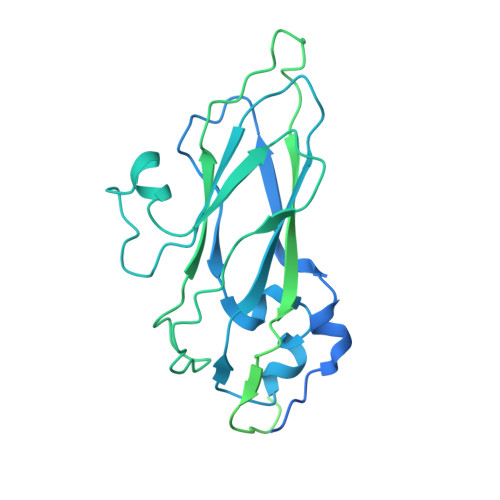Disulfide stabilization of human norovirus GI.1 virus-like particles focuses immune response toward blockade epitopes.
Verardi, R., Lindesmith, L.C., Tsybovsky, Y., Gorman, J., Chuang, G.Y., Edwards, C.E., Brewer-Jensen, P.D., Mallory, M.L., Ou, L., Schon, A., Shi, W., Tully, E.S., Georgiou, G., Baric, R.S., Kwong, P.D.(2020) NPJ Vaccines 5: 110-110
- PubMed: 33318483
- DOI: https://doi.org/10.1038/s41541-020-00260-w
- Primary Citation of Related Structures:
7KJP - PubMed Abstract:
Human noroviruses are non-enveloped, single-strand RNA viruses that cause pandemic outbreaks of acute gastroenteritis. A bivalent vaccine containing GI.1 and GII.4 virus-like particles (VLPs) has been shown to be safe and highly immunogenic, but its efficacy and durability have been limited. Here, we show that norovirus GI.1 VLPs are unstable and contain a substantial fraction of dissociated VLP components. Broadly reactive, non-neutralizing antibodies isolated from vaccinated donors bound to the dissociated components, but not to the intact VLPs. Engineering of interprotomer disulfide bonds within the shell domain prevented disassembly of the VLPs, while preserving antibody accessibility to blockade epitopes. Without adjuvant, mice immunized with stabilized GI.1 VLPs developed faster blockade antibody titers compared to immunization with wild-type GI.1 VLPs. In addition, immunization with stabilized particles focused immune responses toward surface-exposed epitopes and away from occluded epitopes. Overall, disulfide-stabilized norovirus GI.1 VLPs elicited improved responses over the non-disulfide-stabilized version, suggesting their promise as candidate vaccines.
- Vaccine Research Center, National Institute of Allergy and Infectious Diseases, National Institutes of Health, Bethesda, 20892, MD, USA.
Organizational Affiliation:
















